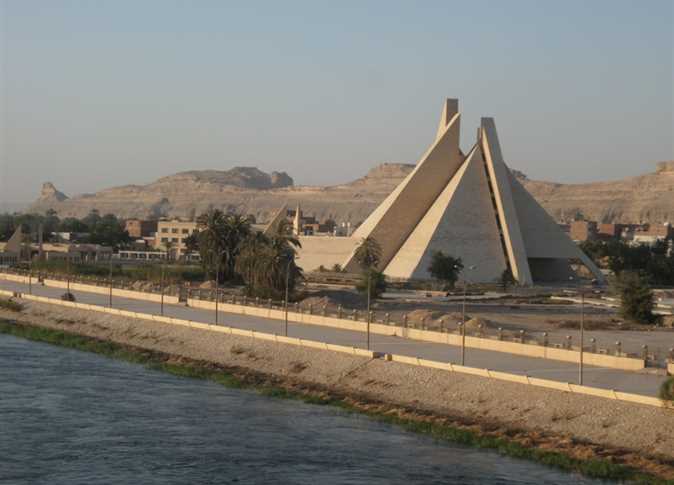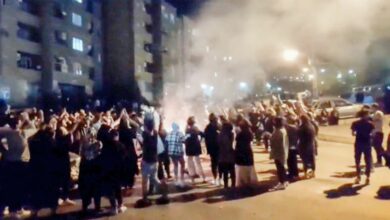Hala Imam graduated with a bachelor's degree in Costume and Set Design. She went on to study modern dance at the Cairo Opera House's Modern Dance School, and then became a member of the Modern Dance Company there. She served as director of the school for over six years and has participated in over 35 performances throughout her career.
In Part II of a two-part interview, Imam talks to Al-Masry Al-Youm about the challenges and rewards of teaching young Egyptians about dance, fighting corruption, and taking over from a "senile elite."
Al-Masry Al-Youm: Who set the curriculum of the school?
Hala Imam: When I first joined there was a set schedule developed by Walid Aouni who selected the subjects based on importance. For example, you had to study classical ballet because it is the base of any modern dance, solfege because you have to understand music and rhythm, drama so you can understand the logic of performance, history of art, history of music, and so on.
It was up to me to decide what subject matter should be covered because the actual content of the classes was not outlined in the school charter. I made these decisions based on my own experience as a student and a performer. I could see that, for example, students must have classic everyday and solfege three times a week, or drama three times a week and history of art twice a week and so on.
Al-Masry: Was there any oversight or supervision of you or the school from the Ministry or the Endowment?
Imam: No.
Al-Masry: How did you evaluate the students? Did they audition again? Or sit for an exam?
Imam: There was no evaluation per se–there was the end of year school performance where each student would strive to participate and do his or her best to get a position in the front lines so when parents and friends attended they would see the improvement.
But I thought this was not very effective. Because the school term ran for eight months, from September till June, so you cannot have a single evaluation in June. Students would not be motivated to keep bettering themselves–you can slack off all year and only work the last few weeks before the final school performance.
I tried to motivate the students by assigning individual projects to each and getting the teachers to watch and review the projects. I asked the teachers to run monthly progress reports on the students with comments on how each student is developing so students would get a chance to get regular feedback on how they are doing.
No one made these suggestions and no one in particular provided me with any kind of support. I came up with these ideas when I was facing the problems of demotivation, increasing absenteeism, etc.
For example, I decided to make two school performances a year so students are constantly working on something. This succeeded in engaging the students–they started coming more frequently and working more with their teachers. I went further and asked Aouni to take some of the advanced students into his corps de ballet in the dance company, and I also asked the independent dance companies and choreographers to include the students in their performances and pieces.
There was no charter, no regulations–it was up to me to find ways to motivate students to regularly attend, to want to develop and advance.
Al-Masry: What criteria did use in accepting new students? What kind of students did you get and did that change how you teach dance?
Imam: To answer this question I would have to go back and examine on what basis Aouni selected his first batch of students, but, unfortunately, I have no idea what the selection criteria was. But I had a set criteria, I knew beforehand that there was no time or opportunity to work on people's bodies the same way the ballet institute and other specialized schools would, so I selected people on the basis of minimum physical ability. I was not very keen that incoming students do extraordinary movements, but I made sure that when given a simple choreography it could executed with facility, that there was a basic muscle and neurological coordination.
They also needed to have a basic sense of rhythm. I am not saying they needed exceptional musical talents, but just the capacity to locate the beat and move to it. In addition it was flexibility, those who can move their extremities without much difficulty or strain on their bodies. And, finally, charisma. You cannot perform on stage without commanding a certain presence. I could not select students who I felt did not grab my attention when they were moving on stage.
Because of all that I ended up picking only four students!
As for what kind of students did we get–I had students from all walks of life. I had doctors, lawyers, accountants, engineers … who all shared the same passion for dance. It was very interesting to have this very diverse group of people dancing in one space and to see how each of them interpret the movement differently, according to his or her own unique way of seeing the world. Unlike students of the ballet institute, for example–who get to study dance at such an early age, where movement is engraved in their bodies and they never have to think twice about it–we all did the same thing: We would study the movement very carefully and try to think of how we could execute it with our existing body as it is, with all its limitations.
We would each approach the movement based on our education and background. For example if you had a student of fine arts, she would understand the movement in terms of lines and canvas, and an architect in terms of balance and angles, and so on.
Al-Masry: When did you start facing problems running the school and working with the Modern Dance Company?
Imam: I worked with the company for five years,and was never acknowledged as a dancer or received any kind of recognition. It's always Aouni and that’s it. This happens in everything: press interviews,TV interviews, school performances that I personally worked to get together, and I was never acknowledged. Up to a point I didn't care, but it really got to me when people started asking, “Who are you?” I don't mind if it's Aouni and Hala, if at least I am acknowledged for all my work, but to pose the question “Who is Hala and what is she doing?” after all the work and effort I have been doing, that was it for me.
And last June I decided to act against this.
This last year I was completely drained on all levels. Especially since Aouni became artistic director of the new dance company Knights of the Orient, on top of all his other commitments, which made it even more difficult for him to be involved in the school. As you know, I had to battle with the system as well. The Cultural Development Endowment refused to hire me and therefore, according to them, I am not officially running the school, my signature is not recognized as valid to authorize anything. I was even denied entrance to the Endowment building because the director believed that I did not address him properly as his position dictates. So Aouni had to sign all the paperwork, but when he was not available to sign, things were stalled even further.
My last year as director was a horrible one. I could not find a single teacher for the school. Can you imagine with all the choreographers and teachers we have I couldn't find anyone who was willing to teach? I had to improvise and get teachers from unusual places (i.e. fitness centers). Potential teachers were now busy teaching at the new dance company, which pays more.
But how do I deal with it? I have no animosity with any of the teachers or instructors but Aouni has all kind of problems with everyone. Because it is called Walid Aouni's school, no one wants to teach at the school.
Students started dropping out. Instead of having 20 students, I ended up having nine. There are no classes, students move to new school years without actually advancing. The new students have no teachers to teach them. Last year he took 125 dancers and teachers from Egypt for a royal ceremony for the King of Bahrain, I had only two teachers left–18 classes taught by two teachers.
This is when I started questioning the effort. I was willing to go so far in the hope that the school would actually function and help change things, but if it was falling apart, what was the point? It came to a dramatic climax when I was invited to a symposium in Turkey on dance pedagogy in the Arab world. Aouni was furious that I was invited and he was not. His reasoning was that I was only the administrator of the school while he was the artistic director.
This led to a bitter confrontation between us, in which I decided to walk out from all my engagements with the Cairo Opera House, the Dance School and the Modern Dance Company.
Al-Masry: If you want to perform outside the monopoly of the Cairo Opera House and its affiliates, why don't tou perform much with independent choreographers and dance companies?
Imam: When I started frequenting the school I started hearing about other dancers and choreographers like Karima Mansour, Mohamed Shafik, Reem Hegab, Dalia el Abd–I felt sad that these people were able to study, they were able to be who they wanted to be, they have vision.
But I also felt that there was no competition. There is only one dance company at the Opera House and that is it. This horrible monopoly that just won't let things grow and evolve.
To give you an example, the Cairo Opera House was opened in 1988 and Abdel Moniem Kamel was artistic director of the company, and now we are 2011 and he still is! I started feeling that corruption is everywhere even in the Opera. But that did not prevent me from working with those artists and choreographers. I have worked with a lot of people. I have worked in performances with choreographer Dalia El-Abd, with choreographer Reem Hegab, I have worked with Sally Ahmed (the principle dancer of Aouni's Dance Company), but I have encountered tragedies working with those individuals.
Let it be clear that I have benefited from every one of the choreographers I worked with, because every one of them is better than me in a way–by tragedy I mean the role of the government.
The government does not provide independent choreographers and independent dance companies any resources to make their work easier and in the very least presentable. The only time where you can actually present your work is the annual Modern Dance Festival–you cannot rent a state theater. The only way you can present your work is through independent small theaters (Rawabet Theatre, the Sawy Cultural Wheel, etc). But they do not provide space for you to rehearse, they do not give you a chance to create your set or lighting plan or even a costume workshop where you can work on your scenography and costume design. They really provide nothing.
When I worked with those choreographers, and with all due respect to them–and as much as the creative process was a democratic and everyone's input was taken into consideration–in the end these performances looked poor. For example when I work on a piece with X choreographer and rehearse in a 2 x 2 meter room, how can I master the musical cues? How can six dancers rehearse in an ordinary room and master the choreography of rise and fall, lift and release? We end up rehearsing two dancers at a time! We are only given the stage the day of the performance, which barely gives you enough time to set the lights, mark the spots and set the music. You barely have enough time to do a general rehearsal. And your general rehearsal is right in front of the audience!
It becomes impossible to synchronize the musical cues with the space because you are not used to the scale of the stage, so instead of dancing for a 20 seconds in 2 meters, you dance in 20 seconds for 6 meters. The performance comes out completely under-rehearsed just by the very fact that you weren't given the stage to do more rehearsal.
Can you imagine that each dancer has to pay to make his or her own costume? Can you imagine that we have to pay for the advertisement, brochures and fliers?
My experience in working with independent choreographers was rewarding in the sense that I benefited a lot from what they have to say, how they trained me, their technique, but as for being satisfied internally about the performances I participated in, after watching them later, I have to say I was not happy with how they looked.
This is not their fault, this the government's fault.
To train in a tiny room at an independent theater space for months, then present this work on a stage as big as Ghomhoriya Theatre, I am sorry this just does not work. And dance training and rehearsing requires a specific dance floor, or you risk serious injuries to the knees, toes, elbows and all your joints!
Al-Masry: Did you consider uniting your efforts, as one of the few very people in the Arab world that actually has experience running a dance school, to team up with other independent artists and choreographers, approach sponsors and donors, or establish an art center or school? Bearing in mind that you as a collective definitely have the legitimate claim to ask for this kind of support.
Imam: I won't say that I didn't think about it. I did. And I thought about contacting those I know and I have worked with, Dalia Al-Abd, Reem Hegab, Karima Mansour, who I know are interested in working to change the current situation. But then there is a lot of production politics involved. These individuals are strictly dancers and choreographers. I am a designer and I already have my income and financial support outside of the dance world. They, however, are not immune or neutral to the politics of the their medium, the competition between them is inevitable due to very limited resources.
Aside from that, each and every one of those choreographers and artists is a unique and leading character. They are not used to working together in a group and they are not used to being led by one individual. Trying to reconcile the differences between them and coordinating efforts drains all the energy that I have!
This did not stop me! I decided that instead of trying to reconcile irreconcilables I would at least begin my initiative alone. I decided to get an apartment–I am a designer and my husband an architect–and use the place as an ideal dance space. And even work on the schedule, since I already have the experience and the know-how, and I have all the contacts for teachers and instructors and what not.
But then I realized that all this needs funding! And a lot of it. And I am the worst person to fundraise.
I didn't think of the amount of paperwork needed for permits and licenses, which in itself costs a fortune, not only for the permits, but to bribe everyone involved, in addition to the building material for the special dance floor, the rental of the place, the lighting, the air conditioning, etc. I could not fundraise and I was not sure who to approach for getting funds.
I decided to amend my plans and work with one of those established artists and choreographers–perhaps they would be better than me in securing funds or finding the requisite structural support to establish this independent school or center. I could then join them and be the administrator as I was with Aouni.
But when I approached them I found that each is busy with his career. Yes, they were enthusiastic about taking on an initiative and working on it, but they had other priorities that they are working on (developing a new piece, touring with a piece, working on a workshop).
Al-Masry: How did things resolve themselves and what are you doing now?
Imam: After I quit, the school shut down. Aouni decided to reappropriate the school to the benefit of his new dance company, the Knights of the Orient. Since he is in need of 70 professional dancers, 35 male and 35 female, he decided to reopen the school as a one-year study program, where professional dancers could join, take all the requisite theoretical and physical training and then they would be eligible to join his dance company. He would use the teachers that are already involved in his dance company and he asked me to come run this school.
Walid tried to change the school charter and enact some changes that would enable me to officially run the school and go beyond this state of deadlock. However, there was no time, and the revolution broke out and as you know everything was dismantled. With the departure of Farouk Hosni as Minister of Culture, and the separation between Antiquities and Culture, every structure that we work with has lost funding. Hosni used to fund the art centers from the Antiquities budget, but since (Zahi) Hawass took over he stopped the funding.
And since these structures (the school being one of them) are not for-profit organizations, there is a complete ambivalence as to what is going to happen now. How will we sustain these structures with the absence of a minister and with complete withdrawal of funding?
There are several scenarios. The school grounds can be used as a training center for the ministry or the theater can be used to screen performances, there are many possibilities. I was contacted by Aouni and we are supposed to meet to discuss how can we still run the school in these new circumstances and make sure that the current enrolled students can actually graduate.
As you might have heard there is now a coalition of independent artists who are trying to negotiate their way into demanding a more free creative atmosphere, the establishment of a syndicate, the abolition of censorship, access to state theaters, etc. I think that dancers and choreographers should have the same opportunity to have access to the school to teach and exchange and that the school as a structure should continue in any way possible and make use of the changes sweeping the country to make everything more open, more accessible. The cultural sector is not isolated from the current events and we, as dancers, performers, choreographers, artists, should make the best out of this situation by uniting our efforts and goals in shaping the outcome of this change to our favor.
The coalition of independent artists should demand that the school be open to independent instructors from across the artistic range, the school facilities should open to all artists and the stage should be used to regularly screen artists' work.
This is the moment that we have all been waiting for, to end the atmosphere of corruption and monopoly by a vicious, senile elite.




